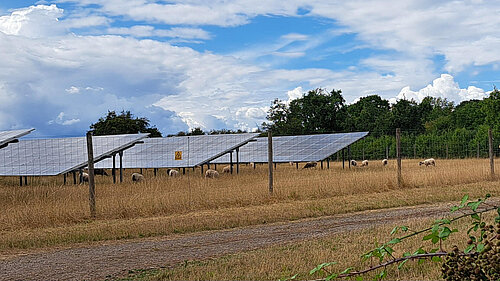Solar farms versus food production

Solar farms versus food production
As a district councillor, Gill Moseley is closely involved in development planning. Here she explores some of the issues raised by large-scale solar farms
The need for renewable energy, including solar farms, is well recognised. However, the argument for putting solar panels on agricultural land often meets well-founded objections. Harm to the landscape and wildlife are among the reasons on which refusal of applications has been based both locally and nationally.
As far as the commercial solar farm development companies are concerned, and there are many of them, placing solar panels on farmland is a relatively easy win. Many farmers are looking to diversify in the face of a difficult agricultural economy. Solar farms offer an opportunity for assured income over 40 years, the current lifespan of new solar farms.
Many people wonder how much farmland, particularly that of high quality such as we have around Newent, is lost to solar farms (and housing development) and would better be kept in agricultural usage to protect our UK food security. The fact is that quite a small proportion is taken up in solar energy production or new housing when the bigger picture is considered, but nevertheless, as a well-known supermarket states, every little helps.
We might also wonder how much land that could produce food is taken up by leisure activities such as golf, for equestrian use and for the newly popular dog activity areas for that matter.
But take the topic of agrivoltaics. This is a system where farmers can continue to grow crops under solar panels which are constructed to allow specially designed farm machinery to work under elevated panels. Some crops benefit from shadier conditions. Evaporation is reduced under solar arrays which, with the increasing frequency of heat waves, must be worthy of consideration. The downside is that greater investment is needed upfront. In Japan and America for example, farmers are working in this way for reasons of climate and shortage of space.
At present, in the UK, farmers generally only graze sheep or combine wildflower meadows, sometimes in association with beekeeping, in tandem with solar farms.
Under the government’s forthcoming Future Homes Standards, applications which are made for future housing will need to include the installation of solar panels amongst other features to make houses more energy efficient. The legislation will take effect next year. At present there is no legislation to compel developers of commercial or public buildings to make their buildings highly energy efficient. However, the scale of the potential cost benefits is often incentive enough. The new Leckhampton Secondary School in Cheltenham, and a garden centre near Newent, provide two good examples in the county. The Forest of Dean District Council has invested in installing rooftop solar panels on its offices in Coleford and supports the Aurora Project in the shape of Forest Community Energy which has already helped to install solar panels on Lydney Leisure Centre.